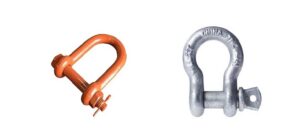There are many different sizes, fabrications, types, and styles of shackles. When you have so many different options, it can be hard to choose the right one for your project. Knowing the differences between the common kinds of shackles will help you make the best choice.

Anchor Shackles
Some people use the terms anchor and bow shackles interchangeably because both refer to shackles with rounded, larger appearances. However, bow shackles often have more defined bow areas than anchor shackles.
The rounded appearance of anchor and bow shackles lets them handle loads going in different directions. With the larger loop, these shackles are not quite as strong, but they can handle larger straps.
Chain Shackles
Some people call this type of shackle a D-shackle because of its shape. Chain shackles are narrower than anchors or bow shackles, and they have pin closures. These shackles have a smaller loop, which means that they can take high loads in line. Racking and side loads might bend or twist this type of shackle. You can usually find chain shackles in stainless steel and galvanized metal. There are usually different options for the pins.
Galvanized Vs. Stainless Steel Shackles
Both of these types of metal provide excellent protection against corrosion and rust, so either type is a good option. Galvanized steel is perfect for industrial areas, as you won’t have to worry about the moisture in the air. There is a coating of zinc oxide to protect the underlying steel from oxidation. It is often less expensive than stainless steel.
On the other hand, stainless steel can resist corrosion well, making it highly suitable for marine applications. For example, type 316 stainless steel is marine-grade. It has molybdenum, so it can resist the ocean spray and mist well. It is perfect for high chloride environments and extreme conditions. With the stainless steel equipment, you can use it for yacht rigging and sailing applications.
Swivel Eye Snap Shackles
Snap shackles have a spring-activated mechanism, so you can use them quickly with only one hand. These are perfect when you need to complete the job fast or if you need to connect and disconnect often. Because the working load limit is usually lower than with pin or bolt type shackles, you might not want to use snap shackles for heavy-duty applications.
Choosing the Right Rigging Shackles
The right rigging supply company will help you pick out the best rigging shackles. Murphy Industrial Products, Inc. is always happy to help with this decision. To learn more about our rigging supplies and how these can help you, contact us today to speak with one of our product experts.

